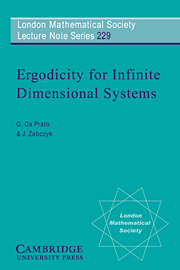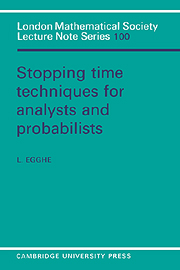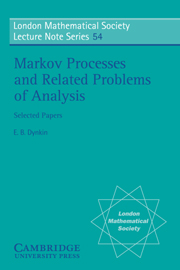Refine search
Actions for selected content:
3023 results in Probability theory and stochastic processes
6 - Brownian local time
-
- Book:
- Brownian Motion
- Published online:
- 05 June 2012
- Print publication:
- 25 March 2010, pp 153-189
-
- Chapter
- Export citation
4 - Hausdorff dimension: Techniques and applications
-
- Book:
- Brownian Motion
- Published online:
- 05 June 2012
- Print publication:
- 25 March 2010, pp 96-117
-
- Chapter
- Export citation
9 - Intersections and self-intersections of Brownian paths
-
- Book:
- Brownian Motion
- Published online:
- 05 June 2012
- Print publication:
- 25 March 2010, pp 255-289
-
- Chapter
- Export citation
Appendix A - Further developments
-
- Book:
- Brownian Motion
- Published online:
- 05 June 2012
- Print publication:
- 25 March 2010, pp 327-345
-
- Chapter
- Export citation
Hints and solutions for selected exercises
-
- Book:
- Brownian Motion
- Published online:
- 05 June 2012
- Print publication:
- 25 March 2010, pp 361-382
-
- Chapter
- Export citation
5 - Brownian motion and random walk
-
- Book:
- Brownian Motion
- Published online:
- 05 June 2012
- Print publication:
- 25 March 2010, pp 118-152
-
- Chapter
- Export citation
Index
-
- Book:
- Brownian Motion
- Published online:
- 05 June 2012
- Print publication:
- 25 March 2010, pp 400-403
-
- Chapter
- Export citation
8 - Potential theory of Brownian motion
-
- Book:
- Brownian Motion
- Published online:
- 05 June 2012
- Print publication:
- 25 March 2010, pp 224-254
-
- Chapter
- Export citation
7 - Stochastic integrals and applications
-
- Book:
- Brownian Motion
- Published online:
- 05 June 2012
- Print publication:
- 25 March 2010, pp 190-223
-
- Chapter
- Export citation
1 - Brownian motion as a random function
-
- Book:
- Brownian Motion
- Published online:
- 05 June 2012
- Print publication:
- 25 March 2010, pp 7-35
-
- Chapter
- Export citation
Preface
-
- Book:
- Brownian Motion
- Published online:
- 05 June 2012
- Print publication:
- 25 March 2010, pp viii-ix
-
- Chapter
- Export citation
2 - Brownian motion as a strong Markov process
-
- Book:
- Brownian Motion
- Published online:
- 05 June 2012
- Print publication:
- 25 March 2010, pp 36-64
-
- Chapter
- Export citation
Frontmatter
-
- Book:
- Brownian Motion
- Published online:
- 05 June 2012
- Print publication:
- 25 March 2010, pp i-iv
-
- Chapter
- Export citation
Appendix B - Background and prerequisites
-
- Book:
- Brownian Motion
- Published online:
- 05 June 2012
- Print publication:
- 25 March 2010, pp 346-360
-
- Chapter
- Export citation
Frequently used notation
-
- Book:
- Brownian Motion
- Published online:
- 05 June 2012
- Print publication:
- 25 March 2010, pp x-xii
-
- Chapter
- Export citation
Selected open problems
-
- Book:
- Brownian Motion
- Published online:
- 05 June 2012
- Print publication:
- 25 March 2010, pp 383-385
-
- Chapter
- Export citation

Ergodicity for Infinite Dimensional Systems
-
- Published online:
- 24 March 2010
- Print publication:
- 16 May 1996

Stochastic Equations in Infinite Dimensions
-
- Published online:
- 21 March 2010
- Print publication:
- 03 December 1992

Stopping Time Techniques for Analysts and Probabilists
-
- Published online:
- 20 March 2010
- Print publication:
- 27 September 1984

Markov Processes and Related Problems of Analysis
-
- Published online:
- 18 March 2010
- Print publication:
- 23 September 1982
